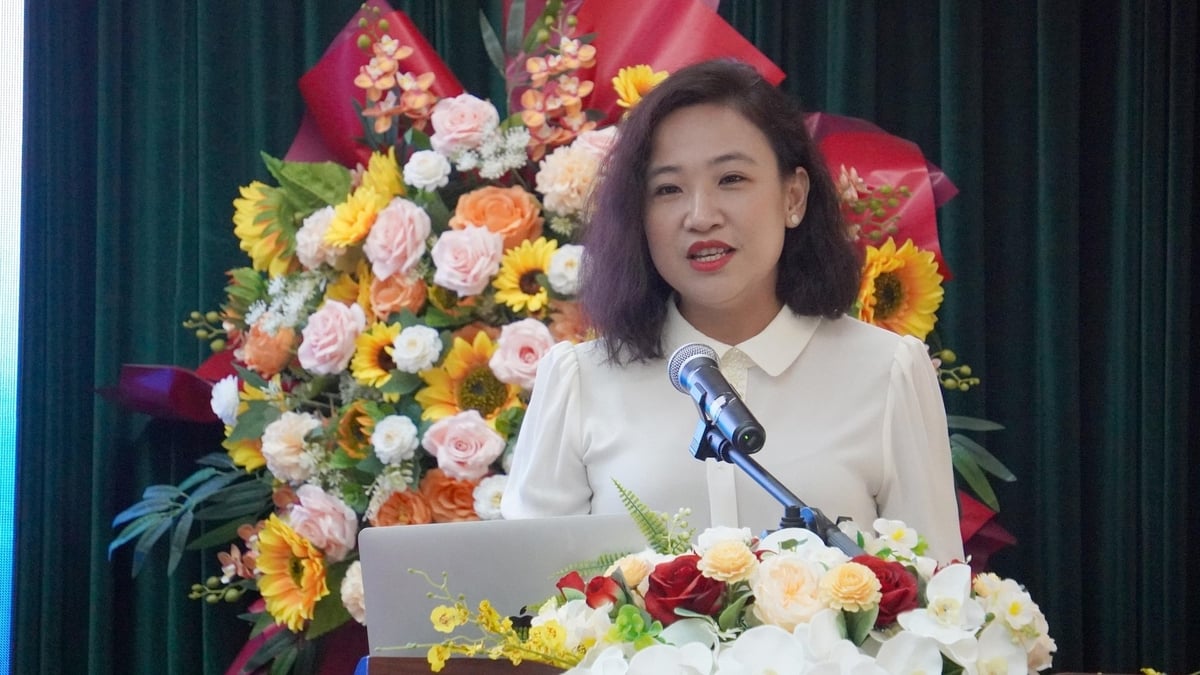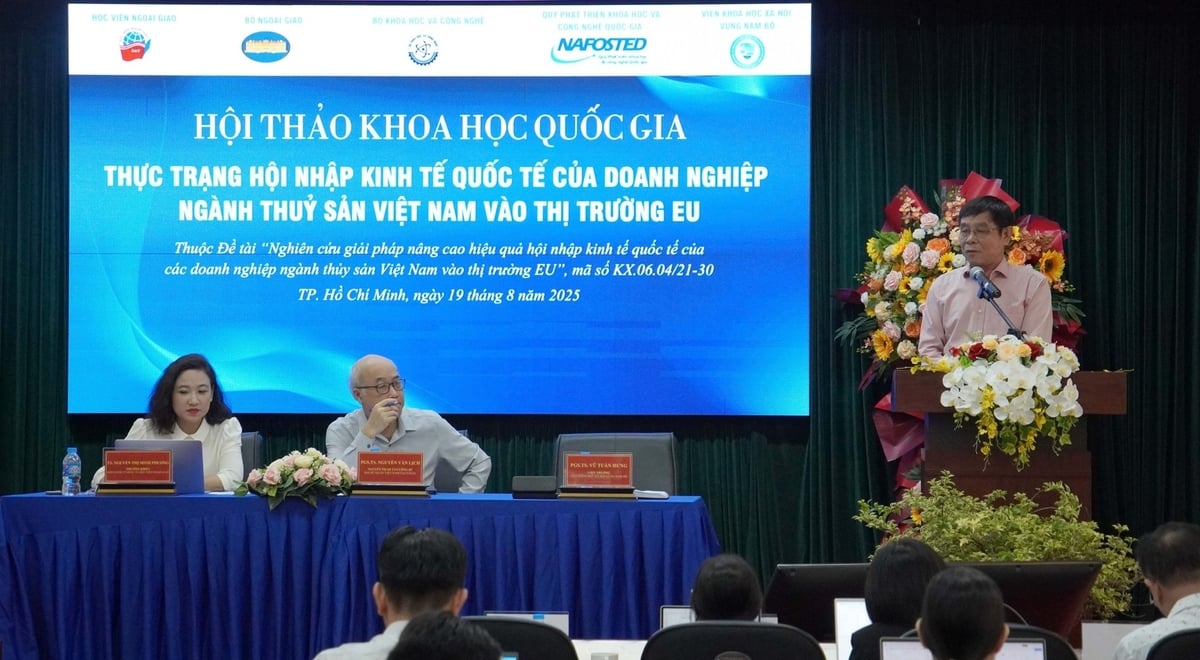December 7, 2025 | 23:47 GMT +7
December 7, 2025 | 23:47 GMT +7
Hotline: 0913.378.918
December 7, 2025 | 23:47 GMT +7
Hotline: 0913.378.918
A national scientific conference entitled "The Integration of Vietnam's Seafood Enterprises into the EU Market" was organized on August 19 by the Diplomatic Academy of Vietnam, which is under the Ministry of Foreign Affairs, in collaboration with the Southern Institute of Social Sciences. The event was a component of a national-level research initiative directed by Dr. Nguyen Thi Minh Phuong, the Head of the International Economics Department at the Diplomatic Academy.
Seafood continues to be a significant economic sector in Vietnam, providing employment opportunities for over four million individuals and contributing approximately 4 - 5% of the country's GDP. In 2024, seafood exports generated 10 billion USD, a 3% increase from 2023, but they remain below the 11 billion USD apex achieved in 2022. The global market's fluctuations and competitive pressures are underscored by the figures. Vietnam remains one of the world's top three seafood exporters, despite the setback.

Dr. Nguyen Thi Minh Phuong, Head of the Faculty of International Economics (Diplomatic Academy, Ministry of Foreign Affairs). Photo: Le Binh.
The EU is the fourth-largest seafood export destination for Vietnam, and Vietnam is the second-largest Asian seafood supplier to the EU, according to Dr. Phuong. The EVFTA has generated novel opportunities for Vietnamese companies to bolster their market presence, diversify export destinations, and mitigate trade risks. However, the road ahead continues to be difficult.
"The European Union establishes rigorous standards for food safety, quality, and traceability", Dr. Phuong stated that these are significant technical obstacles that must be overcome in order to gain access to the market, but they also pose significant challenges for numerous Vietnamese companies.

Mr. Nguyen Thanh Loc: "90% of exported products still carry imported brands and in the past 5 years, exports to the EU have decreased by 70-80% due to management problems and slow resolution of difficulties". Photo: Le Binh.
She further stated that the utilization of tariff preferences under the EVFTA is still restricted due to the difficulty businesses face in adhering to the norms of origin. Quality, brand development, and participation in distribution chains are also areas in which Vietnamese firms experience deficiencies. The majority of companies are restricted to primary processing or contract manufacturing, which generates minimal added value. Meanwhile, critical phases such as research and development, branding, and international distribution are largely underutilized.
Nguyen Thanh Loc, Chairman of the Ho Chi Minh City Fisheries Association, observed that, from the standpoint of local businesses, the majority of seafood caught in regions such as Ba Ria - Vung Tau is exported in frozen and dried form. However, over 90% of these products are marketed under the importer's brand.
In the past five years, Vietnam's seafood exports to the EU have experienced a significant decline in both volume and value, with a decline of up to 70–80%. This decline is primarily attributable to regulatory limitations, incomplete catch data, and delays in the resolution of obstacles. Loc stated that enterprises are nearly inactive in the EU market, necessitating them to pursue alternative destinations without any long-term strategy.
The conference's experts underscored the necessity of coordinated solutions at three levels: government, associations, and enterprises, in order to overcome these challenges. The government must enhance the legal framework, ensure that regulations are in accordance with practical realities, and provide assistance to businesses in the areas of traceability and sustainability certification. Fisheries associations must serve as an information linkage, offer training to indirect labor forces, and enhance the ability of companies to negotiate and access EU partners. Firms are unable to rely solely on contract processing from a business perspective; they must invest in technology, create sustainable and environmentally friendly products, and establish their own brands.
The conference concluded that the EU is a demanding market, but it also presents a strategic opportunity for Vietnam's aquaculture sector. Vietnamese seafood can preserve its global export status and elevate its national brand by leveraging the EVFTA to its fullest potential, improving competitiveness, and further integrating into global value chains.
Translated by Linh Linh

(VAN) Despite numerous challenges, Vietnam's key seafood products are maintaining strong momentum, setting the stage for full-year exports to potentially reach USD 11 billion.

(VAN) The signing of a protocol between Viet Nam and China on the export of fresh jackfruit represents a significant milestone in agricultural trade cooperation between the two countries.

(VAN) On November 27, the Ninh Binh Department of Agriculture and Environment and the Institute for Green Growth Research organized a training course on greenhouse gas inventory for businesses.

(VAN) China’s cooking oil is suddenly flooding into India. It all comes down to a soybean surplus that Beijing doesn’t quite know what to do with.

(VAN) An Giang promotes supply-demand connections, standardizes quality and builds value chains, creating a foundation for sustainable bird’s nest development and aiming to expand exports.
/2025/11/24/5339-4-nongnghiep-075331.jpg)
(VAN) Recently, the conference on 'Sustainable Fisheries Linkage Chain - Tilapia for Export' took place in Tien Hai commune, Hung Yen province.
/2025/11/21/4309-2-153400_128.jpg)
(VAN) Green and low-emission rice is paving the way for Vietnamese rice to enter high-end markets, marking the beginning of a transformation journey toward greening and elevating the national rice brand.